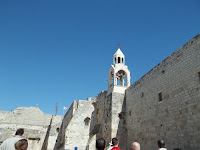 |
| The dome of the Church of the Holy Sepulcher. |
Day 13 - Mount of Olives, Path of Jesus into Jerusalem, Stations of the Cross, Church of the Holy Sepulcher
Not to us, Lord, not to us
But to your name give glory
Because of your faithfulness and love
(Ps 115)
Israelis have a tradition—a very loud tradition—of whooping and clapping whenever an international plane touches down in their homeland. Yesterday at the border crossing between Jordan and Israel, I had the same experience: you cannot help but rejoice when returning to Israel.
Last night and today, and until the end of our pilgrimage, we are in Jerusalem, staying in the Benedictine guesthouse at Dormition Abbey. We began the day at the summit of the Mount of Olives, visiting the place where Jesus taught the “Our Father” to the disciples; where he ascended into heaven (resurrected bodies are heavy: he left behind a footprint in solid stone); the garden (Latin and Armenian), and the cave (where Jesus camped out before the Passover) at Gethsemane; the place where Jesus wept for Jerusalem. Coming down the Mount of Olives and heading into the city, we visited the Greek church of the Dormition, the Latin Church of the Flagellation, Ecce Homo (run by the Sisters of Sion), St. Anne’s, and finally the Holy Sepulcher.
I’m sure you all want to hear about the Holy Sepulcher, but I’ll leave that to another blogger. Today, my heart and soul is all caught up at Gethsemane.
Yet another Barluzzi creation, the Latin Church of Gethsemane is truly a place of darkness, doubt, and struggle. The windows are made from slim-cut alabaster, so the light inside is eerie, opaque, and weak. Beautiful but dark mosaics of twisting olive branches and wild animals cover the domes on the ceiling, as if when inside you walk through the hollows of a dark wood. In the apse and on either side are mosaics done in midnight tones and dusky gold: the disciples asleep, Jesus crying tears of blood, Jesus speaking to his disciples, his friends.
The tympanum above the entrance (a door of that same alabaster decorated in twining bronze branches) bears the words:
SUSTINETE HIC ET VIGILATE MECUM
Or, “Stay here and watch with me.” It is an order. It is one of the saddest phrases I have ever read.
We all, hundreds of tourists, pilgrims, monks, nuns, friars, fathers, believers and non-believers, pass under these words to enter into Gethsemane. They are not an accusation or a request. They are an order.
This past Passion Sunday, I lead a Bible Study where we read the passion account, and my students simply could not understand why the Peter, James, and John, ordered to stay awake with Jesus, fell asleep. They boldly claimed that they would never sleep if Jesus bid them not to, but the truth is they would, we all would.
Stay here and watch with me. These words, over the entrance to the church, are an order not only for Peter, James, and John, but for all people the world over, that’s why we all pass beneath them, whether we wish to obey Christ or not. Like the disciples, we often fail miserably, sleeping when we should be awake, sinning when we should be doing good works.
But the words are not an accusation. God knows we will fail. God has already forgiven our failure, but they are still an order, not a request; required, not bonus. Stepping into the Church at Gethsemane, with all that twisting, frightening darkness around you, you know the struggle in Christ’s heart. You know the struggle in your own. Christ made that one perfect, salvific decision when the rest of us were dozing in the corner, so frightened we could not bear to keep awake, to keep praying, keep doing good.
Stay here and watch with me. I will try.
Siobhan










